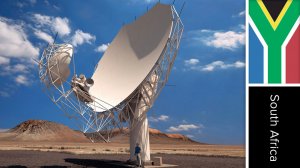
+27 (0)11 0461900
Private Bag X139 Halfway House 1685

MeerKAT telescope project, South Africa
Name and Location
MeerKAT telescope project, Northern Cape, South Africa.
Client
The Square Kilometre Array South Africa (SKA SA) is the agency that is driving South Africa’s bid to host the €1.5-billion international SKA radio telescope and the MeerKAT programme.
Project Description
South Africa’s MeerKAT radio telescope array is intended to be a precursor of the international SKA radio telescope. The MeerKAT evolved from the original idea of a Karoo Array Telescope (KAT).
The reference design specification for the full MeerKAT is 64 offset dishes, each with a diameter of 13.5 m, with single-pixel wideband feeds covering the 500 MHz to 2.5 GHz frequency range. The design means that there are no struts over the dish, which can reduce or scatter incoming radio waves, thus increasing the sensitivity of the antenna.
The completed MeerKAT will have a central core, but some dishes are almost 10 km apart, thus replicating the SKA on a small scale.
It will also facilitate the installation of multiple receiver systems in the primary and secondary focal areas and is the reference design for the midband SKA concept.
The MeerKAT will be delivered in three phases.
The first phase – the MeerKAT Precursor Array, known as KAT-7 and which comprises seven 12-m-diameter composite parabolic dishes at the Karoo site – was completed in 2010.
This prototype interferometer array serves as an engineering test-bed for technologies and systems and as an operational radio telescope. MeerKAT is designed to be integrated into the international Square Kilometre Array (SKA) radio telescope, which will be co-hosted by South Africa and Australia.
Value
The estimated cost is R900-million.
Duration
The commissioning of MeerKAT is scheduled for 2014/15, with the array coming on line for science operations in 2016. This phase includes all antennas, but only the first receiver will be fitted and a processing bandwidth of 750 MHz will be available.
For MeerKAT Phase 2 and Phase 3, the remaining two receivers will be fitted and the processing bandwidth will be increased to at least 2 GHz, and later to 4 GHz.
Latest developments
With the completion of the first dish for the MeerKAT radio telescope array, a key milestone in the development of South Africa’s greatest-ever scientific instrument has been reached. The second antenna will be completed shortly and a new phase in the development of MeerKAT will begin. A lot of testing will be done on these two antennas before the project goes into full production.
Meanwhile, the infrastructure side of the project is almost complete, reports SKA SA associate director: science and engineering professor Justin Jonas. The bulk supply systems – power, water, data lines – are complete.
The site’s road grid is complete. The airfield has been completed. The site has been given its own airstrip, partly because using the airfield at Carnarvon adds two hours to every visit to the site – flying directly to it, therefore saving a lot of time. Another important reason is health and safety: the site is too far from Cape Town for a helicopter to make a direct flight. Any aeromedical evacuation would need to use a fixed-wing aircraft, which is why the runway has an all-weather surface.
The on-site manufacturing facilities, especially those for the dishes, have been expanded to meet the demand for MeerKAT and, afterwards, for Phase 1 of the SKA-mid array. All 64 dishes’ antenna foundations are complete. Their construction absorbed nearly 5 000 m3 of concrete and more than 570 t of steel. The power cabling for all the antennas is in place. The ducting for the optical fibre lines for all the antennas are also in place and fibre cables are being installed in the ducts. The power cables and optical fibre lines go to, and up through, the antenna foundations.
All these cables and lines radiate to the antenna locations from another key piece of infrastructure, which was officially opened on the same day the first antenna was launched in March this year – the Karoo Array Processor Building (KAPB). This will function to deliver key services and support to the MeerKAT and, eventually, the SKA, while minimising radio frequency interference (RFI). Any and all electrical and electronic activity generates RFI, which is why radio telescopes are traditionally located in rural areas.
However, the MeerKAT will be extremely sensitive over a very wide frequency bandwidth (and the SKA even more so). So very low levels of RFI, which will not interfere with existing radio telescopes, will remain a problem for these instruments.
The KAPB provides power conditioning for the radio telescope through the use of three 1.25 MVA diesel-powered rotary uninterrupted power supplies (DRUPS), configured to provide N+1 redundancy. This will ensure a secure power supply for the MeerKAT and for the SKA Phase 1 through the addition of two more DRUPS units.
Space has been reserved to allow for an expansion of the power system as the load increases. The building also houses the telescope’s data processing facility, which contains considerable computer capacity. In addition, there is the associated and essential air-conditioning plant. There is also a room for people using computers and laptops to work.
The KAPB minimises RFI in several ways. It is partly built below ground level – it is neither underground, nor a bunker. The ground provides shielding against RFI and provides some degree of passive temperature control. The data processing facility is completely shielded, as is the scientists’ workroom. Both are in ‘Faraday cages’ – basically, metal boxes that trap all the RFI generated by the computers (even RFI from laptops cannot be allowed). “It’s basically a buried generator, substation, data centre and laboratory, all in one,” concludes Jonas.
Key Contracts and Suppliers
Group Five Coastal (building foundations), Schneider Electric South Africa (building management system), Stratosat Datacom (part of Germany’s Schauenburg Group), with its technology partners, General Dynamics Satcom, of the US, and Vertex Antennentechnik, of Germany (design, construction, installation and commissioning of antennas), Efficient Engineering (antenna pedestals and yokes), Tricom Structures (backup structures for dishes), Titanus Slew Rings (main azimuth bearings), National Research Council of Canada (low-noise amplifiers), Oxford Cryosystems (cryogenic cooling system) and Brink & Heath Civils (foundations).
On Budget and on Time?
The project is on schedule.
Contact Details for Project Information
MeerKAT engineering office, tel +27 21 506 7300 or fax +27 21 506 7375.
Group Five Coastal, tel +27 31 5690300 or fax +27 31 569 0420.
Schneider Electric South Africa, tel +27 11 254 6400,
fax +27 11 254 6700/6704 or email enquiries@za.schneider-electric.com.
Stratosat Datacom, tel +27 11 974 0006 or fax +27 11 974 0068.
General Dynamics Satcom technologies, tel +1 828 464 4141, fax +1 828 464 4147 or email info@gdsatcom.com.
Brink & Heath Civils, tel +27 21 551 2640, fax +27 21 551 2977 or email admin@brinkheath.co.za.
Efficient Engineering , tel +27 11 928 4800, fax +27 11 974 8719 or email info@efficient.co.za.
Tricom Structures, tel +27 12 803 0041, fax +27 12 803 6040 or email info@tricom1.co.za.
Titanus Slew Rings, Shabana Cotwal, +27 11 974 7017, fax+ 27 11 974 8109 or email
shabana@tsr.co.za.
National Research Council of Canada, tel +1 613 993 9101, fax +1 613 952 9907 or email info@nrc-cnrc.gc.ca.
Oxford Cryosystems, tel +44 1993 883488.




